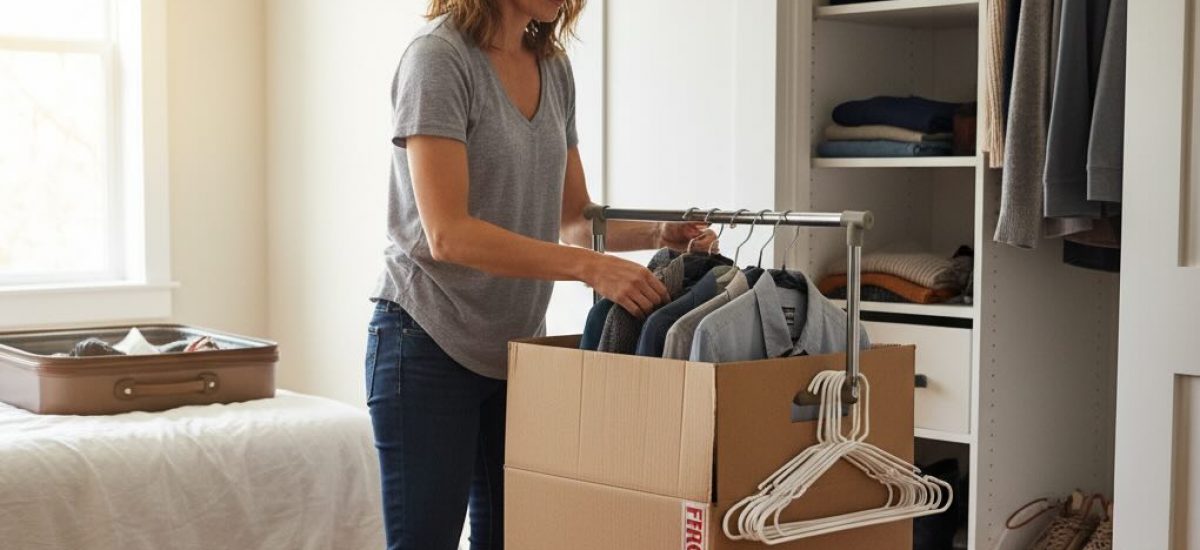Moving house involves many decisions, and while it might not seem as complex as packing electronics, the choices around how to pack clothes when moving can save you significant time and space. Clothing often packs more easily than dishes or furniture, yet the choices still matter: what travels hanging, what folds well, and what feels worth compressing to save space. This guide gathers practical options so a one-bedroom closet or a busy family wardrobe can move without last-minute stress.
Key Points
- Hanging pieces usually travel best in wardrobe boxes, while folded knits and basics settle neatly into standard cartons, suitcases, or plastic bins.
- Vacuum bags save space for bulky seasonal items; they can wrinkle formalwear, so many households reserve them for bedding and puffier layers.
- Keeping clothing in sturdy dresser drawers can work for short, local moves when drawers are light and the furniture is lifted carefully; long-distance moves often prefer empty drawers for safer handling.
- An “Open First Box” (about a week of outfits plus undergarments and work/school needs) makes the first days feel settled while boxes wait their turn.
Choosing a Packing Method That Fits Your Move
Different closets favor different tools. Hanging garments appreciate a straight, protected ride; athletic wear and tees tolerate gentle folding; bulky pieces reward compression. The summary below shows where each method helps and what tradeoffs come with it.
| Method | Best For | Watch-outs |
|---|---|---|
| Wardrobe boxes (with bar) | Dresses, suits, coats, items that crease easily. | Box size is large; plan path/space on elevators and trucks. |
| Medium/large cartons (folded) | Tees, jeans, kids’ clothes, folded pants. | Heavier boxes can be awkward; mixing light linens balances weight. |
| Suitcases & duffels | Everyday outfits and the “Arrival Capsule.” | Wheels help, yet overfilling can strain zippers and backs. |
| Vacuum/compression bags | Puffer coats, comforters, bulky sweaters. | Wrinkling risk for formalwear; avoid if long storage in heat is likely. |
| Plastic bins with lids | Kids’ seasonal bins, garage/attic storage items. | Rigid shapes stack well but consume truck space if underfilled. |
| Clothes left in drawers | Short local hops with light drawers. | Long hauls prefer empty drawers; heavy contents strain joints. |
How to Pack Clothes When Moving Step By Step Guidew
1) Sort by how the item behaves, not by where it lived
Closets often organize by person or season; packing flows more smoothly when items are grouped by how they travel. Hanging garments gather in one area for wardrobe boxes, sturdy knits find a folding station, and bulky pieces sit near compression bags. This small change tends to reduce re-packing and keeps each container consistent in weight and purpose.
2) Build a simple “Open First Box” for the first week
Many households feel more settled when a week of outfits, undergarments, sleepwear, and basic toiletries rides in suitcases or duffels that stay close at hand. Work uniforms, school essentials, and a pair of versatile shoes often join the box. With this small box, unpacking can take a thoughtful pace rather than an urgent one.
3) Give hanging items a protected ride
Wardrobe boxes create a short, portable closet. Garments transfer directly from the rod to the box bar, which limits creasing and saves time at destination. Lightweight shoes or labeled accessory cubes sometimes rest at the bottom of these boxes without overloading them, though anything heavy is usually happier elsewhere.
4) Fold everyday pieces with weight in mind
Medium cartons keep loads friendly for backs and stairs. A gentle fold—thirds for tees, halves for jeans—stacks neatly and stays visible when unpacking. Mixing in light linens balances weight so boxes remain easy to carry, especially in walk-up buildings or narrow halls.
5) Compress only what benefits from it
Compression helps most with puffy items and bedding that rebound well. Formalwear and delicate fabrics do not love long periods under pressure, particularly in warm storage, so many readers reserve vacuum bags for comforters and winter layers and let special pieces travel hanging or lightly folded.
6) Decide thoughtfully about dresser drawers
Local moves sometimes keep lightweight, soft items inside drawers that are secured shut, which reduces packing time and keeps outfits grouped by person. For longer distances or when stairs and turns are involved, empty drawers tend to protect the furniture and make lifting safer.
Patterns That Keep Clothing Boxes Manageable
- Label by room and season, not just by person. “Primary Closet, Fall/Winter Tops” is easier to place than a generic name when multiple rooms are in play.
- Use clear cues for priority. A small “Open First” note on the wardrobe box with work or school outfits helps it rise to the top at delivery.
- Balance each box. A few light pieces on top of dense folded stacks keep weight even and cartons easy to lift.
- Mind the path. Boxes sized for stair turns and elevator doors save time and reduce scuffs in older buildings.
Caring for Fabrics During the Move
Most garments tolerate normal handling, and a little attention goes a long way. Dry cleaning or laundering before packing helps clothes arrive fresh, and breathable garment bags around special pieces reduce snags. In humid climates or during summer moves, silica packets or a small desiccant can ride inside a wardrobe box without touching fabrics directly. On arrival, a few hours on hangers with room to breathe—and, when needed, a quick pass with a steamer—usually restores shape. Before diving into the closet, make sure you’ve covered the administrative side of your journey; the U.S. government offers a helpful guide to moving and organizing your household with key steps like address changes and utility transfers.
Common Missteps and Softer Alternatives
- Overfilling large cartons. Big boxes are tempting for textiles, and they become heavy quickly. Many readers prefer medium cartons for folded items and save large boxes for bedding and pillows.
- Compressing delicate fabrics. Vacuum bags shine for puffers and comforters. Silks, structured dresses, and tailored pieces arrive happier when hung or loosely folded with tissue.
- Skipping the arrival outfits. First nights feel easier when a week’s worth of everyday clothing is already accessible, especially while the rest of the home gets arranged.
- Mixing heavy shoes into clothing boxes. Shoes pack nicely heel-to-toe in their own carton or bin; combining them with knits often creates dense, awkward loads.
FAQ
Are wardrobe boxes worth it for a short move?
Many households find that even on short hops, wardrobe boxes save time and reduce ironing on arrival. If only a handful of pieces truly need to hang, a single wardrobe box can cover the essentials while the rest folds into medium cartons or suitcases.
Is it okay to leave clothes in the dresser?
For nearby, same-day moves, light drawers sometimes travel in place when the furniture is sturdy and paths are simple. For longer distances or tight stair turns, empty drawers protect joints and finishes and make lifting safer for everyone.
Do compression bags damage clothing?
Compression is gentle on items designed to rebound, like down and synthetics. Structured garments and delicate fabrics can wrinkle or hold creases under pressure, so these pieces generally ride hanging or loosely folded.
What should be packed with clothing for the first week?
An “open first box” often includes everyday outfits, undergarments, sleepwear, a light jacket, basic toiletries, any required uniforms, and a small laundry kit. Keeping this in a suitcase or duffel makes the first days feel normal while the closet comes together.
long distance moves
as low as $1748
Long-distance moving all across the United States. Experienced and insured, residential and commercial.
4.9/5 AVERAGE RATING










